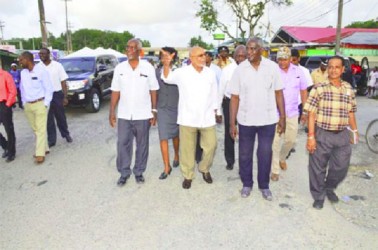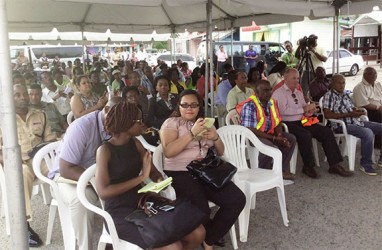A “simple but important ceremony” was held yesterday to mark the commencement of the new US$46.8m West Demerara highway that will help to cut travel time from Vreed-en-Hoop to Parika significantly.
Addressing the gathering at the Vreed-en-Hoop Stelling, President Donald Ramotar said the Ministry of Public Works’ Fourth Road Project is one of many investments that government was undertaking in the region.
He recalled that only a few weeks ago he was in the region to inaugurate the new GPL electricity plant.

He said over the years, government has been developing fairly rapidly despite having to contend with an international financial and economic crisis that impacted the region severely.
To take the country to a much higher level of development, he said, the infrastructure is not sufficient and noted its importance.
Ramotar highlighted plans to upgrade the West Bank Demerara road and said the Canal No 1 and 2 Polders would be upgraded to highway status as well. With general elections weeks away, he said that his government would focus on quality so the road can stand up to more traffic.
Speaking about the growth of some areas on the West Coast including, Vreed-en-Hoop, Parika, Leonora and Tuschen, Ramotar said “transportation is becoming more and more inadequate.”
On that note, he said the need for a new crossing of the Demerara River was becoming extremely important.
Studies have begun for a new bridge across the river and should come on stream within the next five years. That, he said, would help to integrate Georgetown and Vreed-en-Hoop.
He spoke confidently of the construction of the Amaila Falls hydropower project and about connecting Parika with a submarine cable to Leguan and from there to Wakenaam and to the Essequibo Coast.

Minister of Public Works, Robeson Benn, remarked that over the last three years there were 111 road projects costing $1.32B in areas like Goed Fortuin, La Grange, Nismes, La Jalousie and Good Intent as well as side line dams
He reminded residents to make the best use of the roads because they have put in the best designs that would last longer and can accommodate “higher loadings.”
He hopes that the ministry does not have to go back and maintain the roads but said that it would hand over the projects to the Neighbourhood Democratic Council (NDC) and the regional administration.
He said residents should pay an interest in the proper use of the road to ensure its longevity, for instance putting up barriers to prevent heavily laden trucks.
The civil works with respect to the development of the road such as the installing of new upgraded carriageways, pavements for the safety of pedestrians as well as bridges and culverts, would last over three year.
The ministry has had issues with respect to utilities and said “this has been a bugbear with respect to the “East Bank Demerara and has led to its delay.”
He said the contractors have to ensure that as they move forward they clarify the location, depth and quantity of the utilities such as telephone lines and other buried cables. They are becoming significant impediments to the speedy and proper usage of the roads.
Project coordinator, Kester Hinds said through the Caribbean Development Bank-funded project with counterpart funding from Government of Guyana, the West Demerara would see significant improvement in the form of rehabilitation and the provision of pedestrian and cycling facilities.
It would also see the rehabilitation and construction of bridges and culverts. The project, he said, entails significant road safety awareness in the form of educational programmes for schoolchildren and public transportation drivers.




